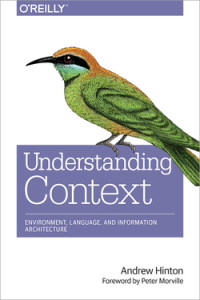 After several years of proposing, writing, revising, and production, Understanding Context is finally a real book. For obvious reasons, I’ve not been especially prolific here at Inkblurt, since every spare moment was mostly used to get the book done.
After several years of proposing, writing, revising, and production, Understanding Context is finally a real book. For obvious reasons, I’ve not been especially prolific here at Inkblurt, since every spare moment was mostly used to get the book done.
And it’s still not really done … like the old saying goes, a work of writing is never finished, only abandoned. As I say in the Preface (now online), the book is definitely an act of understanding that is in progress. It’s an invitation to readers to come along on the journey and keep it moving in their own ways, from their own perspectives.
Since this is my personal blog, I don’t mind saying that this was one of the hardest things I’ve ever done. I’ve always thought of myself as a writer, but secretly worried that I would never have the ability to finish an actual book. My professional or otherwise published writing has always been shorter pieces: poems, stories, essays, articles. Add to that the wacky impostor-syndrome spikes, the anxieties about wading into waters that feel over my head, and the strange self-torture that is looking at one’s own prose at length, with all its bad habits, for months and months: I’m not sure how I didn’t throw in the towel. This all sounds so dramatic, when in fact (as I had to keep reminding myself) writing a book is just a matter of putting a lot of words in a particular order, until you have a book. When it comes down to it, it’s just work. I just have a terribly noisy mind, and a herd-of-cats frontal lobe.
Counterbalancing my shortcomings: I had a lot of support and interest from many kind, optimistic people; and even if I was losing interest and motivation, others were still interested and motivated and telling me to get to work. So I kept doing it. I’m glad I did, and I’m thankful for all those supportive moments of encouragement.
Another thing that’s been bemusing me … it may sound silly, but I did not mean to write such a long book. The short version of what happened: in order for me to write the second half of the book, I had to write the first half as a foundation. So, the first half is pretty dense with theoretical concepts like embodied cognition and semiotics (hopefully with enough concrete examples to make them relevant). If I removed a lot of that stuff, it would’ve taken away the frame that the rest of the book needed.
Generally, there was a frustrating tension between trying to make a book that would be an enjoyably efficient, casual read, and one that puts in print some ideas that I came to believe are essential for design practice in general (and information architecture in particular). I did my best to strike the balance.
I wish this thing well — we’ve been companions for a long time. We still are, I guess, but the relationship is different now. It’s out in the world, having its own life.
If you run across this now-independent companion of mine, let me know.


